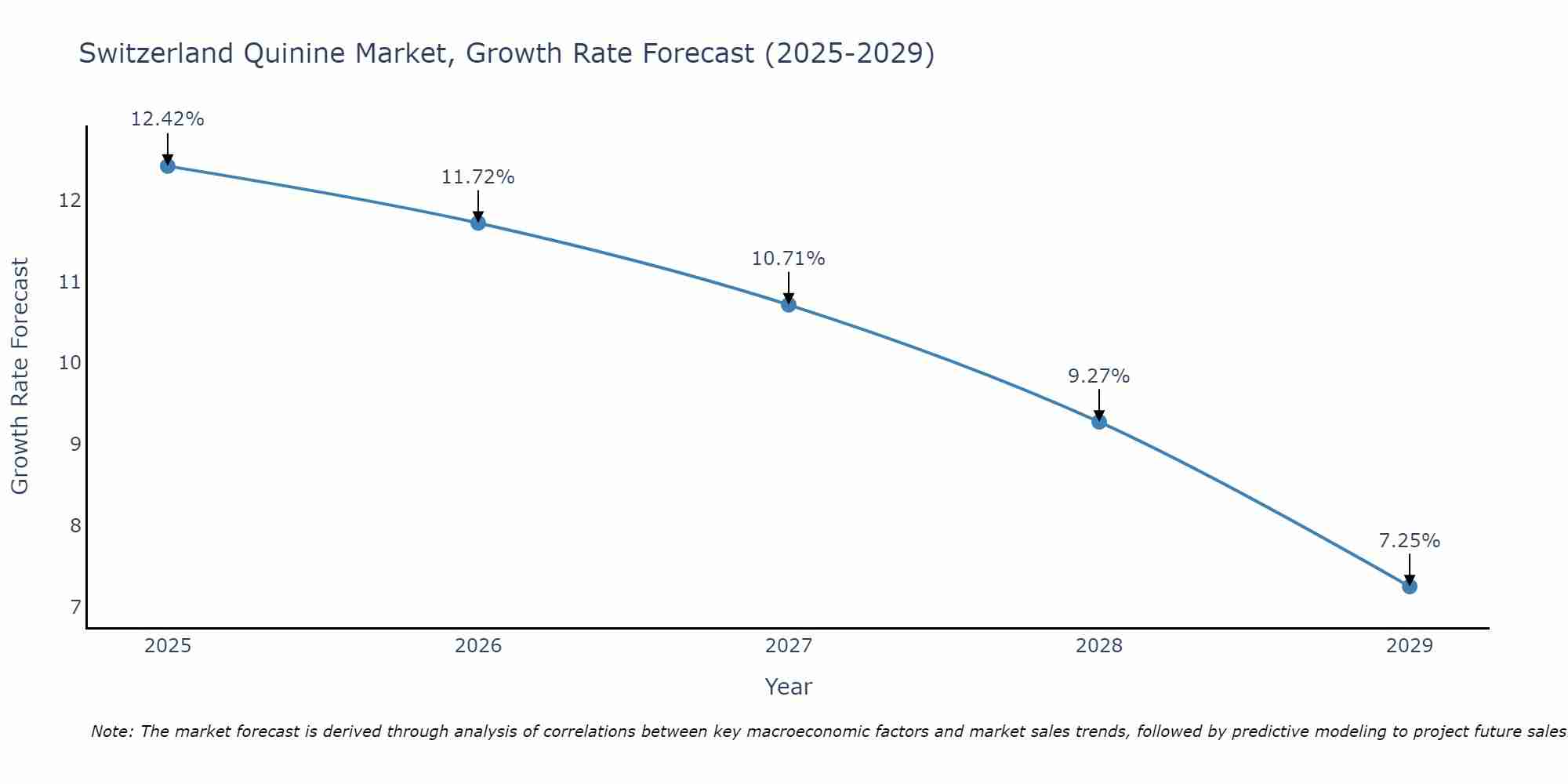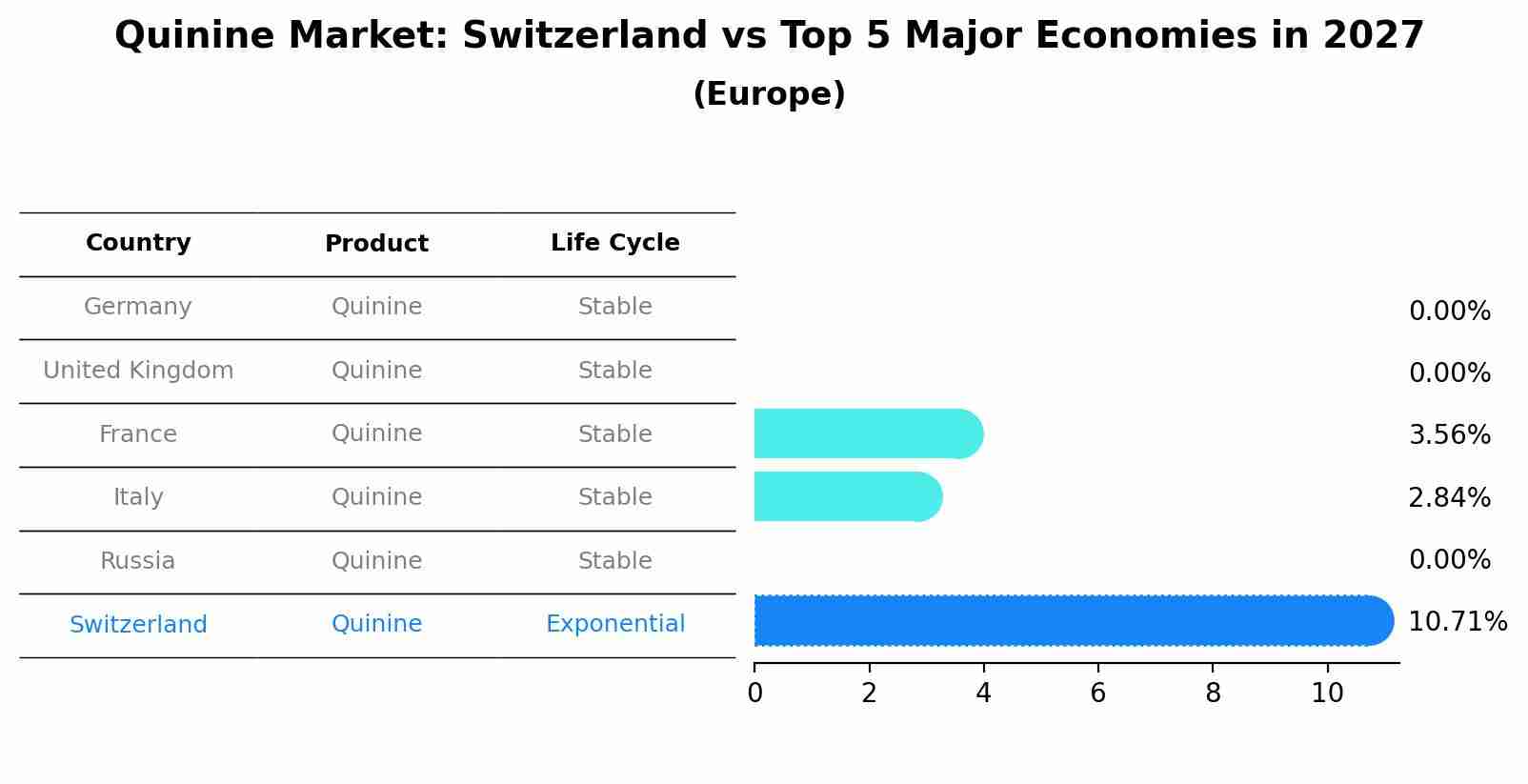Switzerland Quinine Market (2025-2031) | Value, Companies, Industry, Trends, Outlook, Forecast, Growth, Analysis, Segmentation, Size, Revenue & Share
| Product Code: ETC5312528 | Publication Date: Nov 2023 | Updated Date: Aug 2025 | Product Type: Market Research Report | |
| Publisher: 6Wresearch | Author: Bhawna Singh | No. of Pages: 60 | No. of Figures: 30 | No. of Tables: 5 |
Switzerland Quinine Market Size Growth Rate
The Switzerland Quinine Market may undergo a gradual slowdown in growth rates between 2025 and 2029. Beginning strongly at 12.42% in 2025, growth softens to 7.25% in 2029.

Quinine Market: Switzerland vs Top 5 Major Economies in 2027 (Europe)
The Quinine market in Switzerland is projected to grow at a high growth rate of 10.71% by 2027, within the Europe region led by Germany, along with other countries like United Kingdom, France, Italy and Russia, collectively shaping a dynamic and evolving market environment driven by innovation and increasing adoption of emerging technologies.

Switzerland Quinine Market Overview
The quinine market in Switzerland, mainly used for medicinal purposes, is stable but faces challenges from synthetic alternatives and fluctuating raw material prices.
Drivers of the market
The quinine market in Switzerland is driven by the increasing demand for quinine-based products in pharmaceuticals and herbal supplements. Quinine is primarily used for its antimalarial properties and is also utilized in the formulation of tonic water and other beverages. The rising awareness of health benefits associated with quinine and the growing prevalence of malaria in certain regions contribute to the market`s growth. Additionally, the focus on natural and herbal remedies is fostering interest in quinine-containing products.
Challenges of the market
The quinine market faces challenges related to fluctuating raw material prices and availability, which can impact production costs and supply chain stability. Additionally, regulatory compliance concerning safety and efficacy can complicate the development and marketing of quinine products. The market is characterized by intense competition, with numerous players vying for market share, leading to pricing pressures. Furthermore, evolving consumer preferences for natural remedies can shift demand away from quinine, necessitating ongoing innovation and adaptation to maintain market relevance.
Government Policy of the market
Swiss health regulations, particularly those concerning pharmaceuticals, govern the use of quinine in medicinal applications. The governments strict adherence to international pharmaceutical standards ensures that quinine-based medications meet safety and efficacy requirements, especially for the treatment of malaria and other related conditions.
Key Highlights of the Report:
- Switzerland Quinine Market Outlook
- Market Size of Switzerland Quinine Market, 2024
- Forecast of Switzerland Quinine Market, 2031
- Historical Data and Forecast of Switzerland Quinine Revenues & Volume for the Period 2021-2031
- Switzerland Quinine Market Trend Evolution
- Switzerland Quinine Market Drivers and Challenges
- Switzerland Quinine Price Trends
- Switzerland Quinine Porter`s Five Forces
- Switzerland Quinine Industry Life Cycle
- Historical Data and Forecast of Switzerland Quinine Market Revenues & Volume By Mode of Administration for the Period 2021-2031
- Historical Data and Forecast of Switzerland Quinine Market Revenues & Volume By Oral Administration for the Period 2021-2031
- Historical Data and Forecast of Switzerland Quinine Market Revenues & Volume By Intravenous Administration for the Period 2021-2031
- Historical Data and Forecast of Switzerland Quinine Market Revenues & Volume By Intramuscular Administration for the Period 2021-2031
- Historical Data and Forecast of Switzerland Quinine Market Revenues & Volume By Others for the Period 2021-2031
- Historical Data and Forecast of Switzerland Quinine Market Revenues & Volume By Application for the Period 2021-2031
- Historical Data and Forecast of Switzerland Quinine Market Revenues & Volume By Antimalarial for the Period 2021-2031
- Historical Data and Forecast of Switzerland Quinine Market Revenues & Volume By Antipyretic for the Period 2021-2031
- Historical Data and Forecast of Switzerland Quinine Market Revenues & Volume By Others for the Period 2021-2031
- Historical Data and Forecast of Switzerland Quinine Market Revenues & Volume By End-user for the Period 2021-2031
- Historical Data and Forecast of Switzerland Quinine Market Revenues & Volume By Hospitals for the Period 2021-2031
- Historical Data and Forecast of Switzerland Quinine Market Revenues & Volume By Clinics for the Period 2021-2031
- Historical Data and Forecast of Switzerland Quinine Market Revenues & Volume By Ambulatory Surgical Centers for the Period 2021-2031
- Historical Data and Forecast of Switzerland Quinine Market Revenues & Volume By Others for the Period 2021-2031
- Switzerland Quinine Import Export Trade Statistics
- Market Opportunity Assessment By Mode of Administration
- Market Opportunity Assessment By Application
- Market Opportunity Assessment By End-user
- Switzerland Quinine Top Companies Market Share
- Switzerland Quinine Competitive Benchmarking By Technical and Operational Parameters
- Switzerland Quinine Company Profiles
- Switzerland Quinine Key Strategic Recommendations
Frequently Asked Questions About the Market Study (FAQs):
1 Executive Summary |
2 Introduction |
2.1 Key Highlights of the Report |
2.2 Report Description |
2.3 Market Scope & Segmentation |
2.4 Research Methodology |
2.5 Assumptions |
3 Switzerland Quinine Market Overview |
3.1 Switzerland Country Macro Economic Indicators |
3.2 Switzerland Quinine Market Revenues & Volume, 2021 & 2031F |
3.3 Switzerland Quinine Market - Industry Life Cycle |
3.4 Switzerland Quinine Market - Porter's Five Forces |
3.5 Switzerland Quinine Market Revenues & Volume Share, By Mode of Administration, 2021 & 2031F |
3.6 Switzerland Quinine Market Revenues & Volume Share, By Application, 2021 & 2031F |
3.7 Switzerland Quinine Market Revenues & Volume Share, By End-user, 2021 & 2031F |
4 Switzerland Quinine Market Dynamics |
4.1 Impact Analysis |
4.2 Market Drivers |
4.2.1 Increasing awareness about the health benefits of quinine |
4.2.2 Growing demand for natural and organic ingredients in healthcare products |
4.2.3 Rising prevalence of diseases that can be treated with quinine |
4.3 Market Restraints |
4.3.1 Stringent regulations and quality standards in the pharmaceutical industry |
4.3.2 Fluctuating prices of raw materials used in quinine production |
5 Switzerland Quinine Market Trends |
6 Switzerland Quinine Market Segmentations |
6.1 Switzerland Quinine Market, By Mode of Administration |
6.1.1 Overview and Analysis |
6.1.2 Switzerland Quinine Market Revenues & Volume, By Oral Administration, 2021-2031F |
6.1.3 Switzerland Quinine Market Revenues & Volume, By Intravenous Administration, 2021-2031F |
6.1.4 Switzerland Quinine Market Revenues & Volume, By Intramuscular Administration, 2021-2031F |
6.1.5 Switzerland Quinine Market Revenues & Volume, By Others, 2021-2031F |
6.2 Switzerland Quinine Market, By Application |
6.2.1 Overview and Analysis |
6.2.2 Switzerland Quinine Market Revenues & Volume, By Antimalarial, 2021-2031F |
6.2.3 Switzerland Quinine Market Revenues & Volume, By Antipyretic, 2021-2031F |
6.2.4 Switzerland Quinine Market Revenues & Volume, By Others, 2021-2031F |
6.3 Switzerland Quinine Market, By End-user |
6.3.1 Overview and Analysis |
6.3.2 Switzerland Quinine Market Revenues & Volume, By Hospitals, 2021-2031F |
6.3.3 Switzerland Quinine Market Revenues & Volume, By Clinics, 2021-2031F |
6.3.4 Switzerland Quinine Market Revenues & Volume, By Ambulatory Surgical Centers, 2021-2031F |
6.3.5 Switzerland Quinine Market Revenues & Volume, By Others, 2021-2031F |
7 Switzerland Quinine Market Import-Export Trade Statistics |
7.1 Switzerland Quinine Market Export to Major Countries |
7.2 Switzerland Quinine Market Imports from Major Countries |
8 Switzerland Quinine Market Key Performance Indicators |
8.1 Number of new product launches containing quinine |
8.2 Consumer surveys indicating preference for products with quinine |
8.3 Number of research studies highlighting the benefits of quinine in healthcare applications |
9 Switzerland Quinine Market - Opportunity Assessment |
9.1 Switzerland Quinine Market Opportunity Assessment, By Mode of Administration, 2021 & 2031F |
9.2 Switzerland Quinine Market Opportunity Assessment, By Application, 2021 & 2031F |
9.3 Switzerland Quinine Market Opportunity Assessment, By End-user, 2021 & 2031F |
10 Switzerland Quinine Market - Competitive Landscape |
10.1 Switzerland Quinine Market Revenue Share, By Companies, 2024 |
10.2 Switzerland Quinine Market Competitive Benchmarking, By Operating and Technical Parameters |
11 Company Profiles |
12 Recommendations | 13 Disclaimer |
- Single User License$ 1,995
- Department License$ 2,400
- Site License$ 3,120
- Global License$ 3,795
Search
Thought Leadership and Analyst Meet
Our Clients
Related Reports
- Afghanistan Apparel Market (2026-2032) | Growth, Outlook, Industry, Segmentation, Forecast, Size, Companies, Trends, Value, Share, Analysis & Revenue
- Canada Oil and Gas Market (2026-2032) | Share, Segmentation, Value, Industry, Trends, Forecast, Analysis, Size & Revenue, Growth, Competitive Landscape, Outlook, Companies
- Germany Breakfast Food Market (2026-2032) | Industry, Share, Growth, Size, Companies, Value, Analysis, Revenue, Trends, Forecast & Outlook
- Australia Briquette Market (2025-2031) | Growth, Size, Revenue, Forecast, Analysis, Trends, Value, Share, Industry & Companies
- Vietnam System Integrator Market (2025-2031) | Size, Companies, Analysis, Industry, Value, Forecast, Growth, Trends, Revenue & Share
- ASEAN and Thailand Brain Health Supplements Market (2025-2031) | Strategy, Consumer Insights, Analysis, Investment Trends, Opportunities, Growth, Size, Share, Industry, Revenue, Segments, Value, Segmentation, Supply, Forecast, Restraints, Outlook, Competition, Drivers, Trends, Demand, Pricing Analysis, Competitive, Strategic Insights, Companies, Challenges
- ASEAN Bearings Market (2025-2031) | Strategy, Consumer Insights, Analysis, Investment Trends, Opportunities, Growth, Size, Share, Industry, Revenue, Segments, Value, Segmentation, Supply, Forecast, Restraints, Outlook, Competition, Drivers, Trends, Demand, Pricing Analysis, Competitive, Strategic Insights, Companies, Challenges
- Europe Flooring Market (2025-2031) | Outlook, Share, Industry, Trends, Forecast, Companies, Revenue, Size, Analysis, Growth & Value
- Saudi Arabia Manlift Market (2025-2031) | Outlook, Size, Growth, Trends, Companies, Industry, Revenue, Value, Share, Forecast & Analysis
- Uganda Excavator, Crane, and Wheel Loaders Market (2025-2031) | Strategy, Consumer Insights, Analysis, Investment Trends, Opportunities, Growth, Size, Share, Industry, Revenue, Segments, Value, Segmentation, Supply, Forecast, Restraints, Outlook, Competition, Drivers, Trends, Demand, Pricing Analysis, Competitive, Strategic Insights, Companies, Challenges
Industry Events and Analyst Meet
Whitepaper
- Middle East & Africa Commercial Security Market Click here to view more.
- Middle East & Africa Fire Safety Systems & Equipment Market Click here to view more.
- GCC Drone Market Click here to view more.
- Middle East Lighting Fixture Market Click here to view more.
- GCC Physical & Perimeter Security Market Click here to view more.
6WResearch In News
- Doha a strategic location for EV manufacturing hub: IPA Qatar
- Demand for luxury TVs surging in the GCC, says Samsung
- Empowering Growth: The Thriving Journey of Bangladesh’s Cable Industry
- Demand for luxury TVs surging in the GCC, says Samsung
- Video call with a traditional healer? Once unthinkable, it’s now common in South Africa
- Intelligent Buildings To Smooth GCC’s Path To Net Zero


















